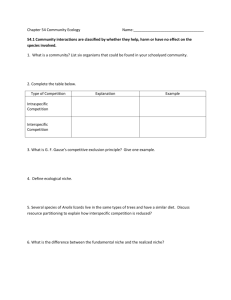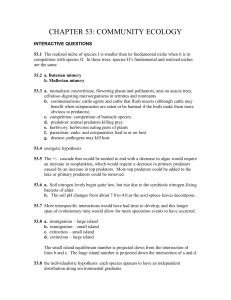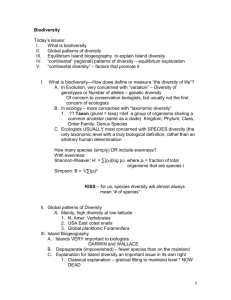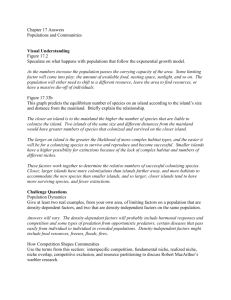File - Biology E
advertisement
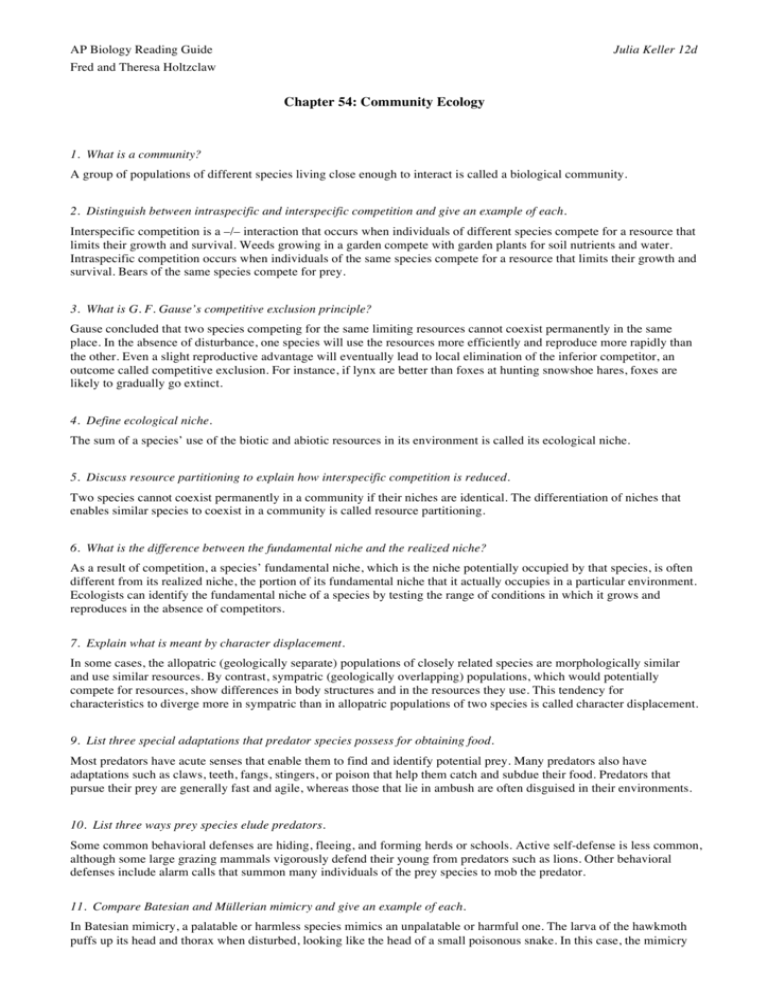
AP Biology Reading Guide Fred and Theresa Holtzclaw Julia Keller 12d Chapter 54: Community Ecology 1. What is a community? A group of populations of different species living close enough to interact is called a biological community. 2. Distinguish between intraspecific and interspecific competition and give an example of each. Interspecific competition is a –/– interaction that occurs when individuals of different species compete for a resource that limits their growth and survival. Weeds growing in a garden compete with garden plants for soil nutrients and water. Intraspecific competition occurs when individuals of the same species compete for a resource that limits their growth and survival. Bears of the same species compete for prey. 3. What is G. F. Gause’s competitive exclusion principle? Gause concluded that two species competing for the same limiting resources cannot coexist permanently in the same place. In the absence of disturbance, one species will use the resources more efficiently and reproduce more rapidly than the other. Even a slight reproductive advantage will eventually lead to local elimination of the inferior competitor, an outcome called competitive exclusion. For instance, if lynx are better than foxes at hunting snowshoe hares, foxes are likely to gradually go extinct. 4. Define ecological niche. The sum of a species’ use of the biotic and abiotic resources in its environment is called its ecological niche. 5. Discuss resource partitioning to explain how interspecific competition is reduced. Two species cannot coexist permanently in a community if their niches are identical. The differentiation of niches that enables similar species to coexist in a community is called resource partitioning. 6. What is the difference between the fundamental niche and the realized niche? As a result of competition, a species’ fundamental niche, which is the niche potentially occupied by that species, is often different from its realized niche, the portion of its fundamental niche that it actually occupies in a particular environment. Ecologists can identify the fundamental niche of a species by testing the range of conditions in which it grows and reproduces in the absence of competitors. 7. Explain what is meant by character displacement. In some cases, the allopatric (geologically separate) populations of closely related species are morphologically similar and use similar resources. By contrast, sympatric (geologically overlapping) populations, which would potentially compete for resources, show differences in body structures and in the resources they use. This tendency for characteristics to diverge more in sympatric than in allopatric populations of two species is called character displacement. 9. List three special adaptations that predator species possess for obtaining food. Most predators have acute senses that enable them to find and identify potential prey. Many predators also have adaptations such as claws, teeth, fangs, stingers, or poison that help them catch and subdue their food. Predators that pursue their prey are generally fast and agile, whereas those that lie in ambush are often disguised in their environments. 10. List three ways prey species elude predators. Some common behavioral defenses are hiding, fleeing, and forming herds or schools. Active self-defense is less common, although some large grazing mammals vigorously defend their young from predators such as lions. Other behavioral defenses include alarm calls that summon many individuals of the prey species to mob the predator. 11. Compare Batesian and Müllerian mimicry and give an example of each. In Batesian mimicry, a palatable or harmless species mimics an unpalatable or harmful one. The larva of the hawkmoth puffs up its head and thorax when disturbed, looking like the head of a small poisonous snake. In this case, the mimicry even involves behavior; the larva weaves its head back and forth and hisses like a snake. In Müllerian mimicry, two or more unpalatable species, such as the cuckoo bee and yellow jacket, resemble each other. Presumably, the more unpalatable prey there are, the more quickly predators learn to avoid prey with that particular appearance. The shared appearance thus becomes a kind of aposematic (warning) coloration. In an example of convergent evolution, unpalatable animals in several different taxa have similar patterns of coloration, such as black and yellow or red stripes in yellow jackets and coral snakes. 12. What is herbivory? Herbivory refers to a +/– interaction in which an organism eats parts of a plant or alga. 13. List two adaptations for resisting predation and herbivory. A plant’s arsenal against herbivores may feature chemical toxins or structures such as spines and thorns. Among the plant compounds that serve as chemical weapons are the poison strychnine, nicotine, and tannins. 14. Describe and give an example of symbiosis, parasitism, commensalism, and mutualism. In a symbiotic relationship, individuals of two or more species live in direct and intimate contact with one another. Parasitism is a +/– interaction in which one organism, the parasite, derives its nourishment from another organism, its host, which is harmed in the process. Mutualism is an interspecific interaction that benefits both species. In obligate mutualism, at least one species has lost the ability to survive without its partner. In facultative mutualism, both species can survive alone. An interaction that benefits one species but neither harms nor helps the other (+/0) is called commensalism. Commensal interactions are difficult to document in nature because any close association between species likely affects both species, even if only slightly. Some associations that are possibly commensal involve one species obtaining food that is inadvertently exposed by another. 16. Use +/– symbols to indicate how interspecific interactions affect the survival and reproduction of the two species. type of interaction effect on interacting species predation +/– commensalism +/0 mutualism +/+ parasitism +/– interspecific competition –/– herbivory +/– 17. What is species diversity? What are its two components? The species diversity of a community is a measure of the variety of different kinds of organisms that make up the community. Its two components are species richness, the number of different species in the community, and the relative abundance of the different species, the proportion each species represents of all individuals in the community. 18. What does an ecologist summarize in a food web? Food chains are not isolated units but are linked together in food webs. Ecologists summarize the trophic relationships of a community by diagramming a food web with arrows linking species according to who eats whom. 20. Label the pictured food chain. ! The structure and dynamics of a community depend on its trophic structure, the feeding relationships between organisms. The transfer of food energy up the trophic levels from its source in plants and other autotrophic organisms (primary producers) through herbivores (primary consumers) to carnivores (secondary, tertiary, and quaternary consumers) and eventually to decomposers is referred to as a food chain. 21. Why are food chains limited in length, according to the energetic hypothesis? Most food webs studied to date have chains consisting of five or fewer links. The energetic hypothesis suggests that the length of a food chain is limited by the inefficiency of energy transfer along the chain. Only about 10% of the energy stored in the organic matter of each trophic level is converted to organic matter at the next trophic level. Thus, a producer level consisting of 100kg of plant material can support about 10kg of herbivore biomass (the total mass of all individuals in a population) and 1kg of carnivore biomass. The dynamic stability hypothesis proposes that long food chains are less stable than short chains. Population fluctuations at lower trophic levels are magnified at higher levels, potentially causing the local extinction of top predators. The longer a food chain, the more slowly its top predators can recover from environmental setbacks. 22. What is a dominant species? Dominant species in a community are the species that are the most abundant or that collectively have the highest biomass. As a result, dominant species exert a powerful control over the occurrence and distribution of other species. 23. How is a keystone species different from a dominant species? In contrast to dominant species, keystone species are not usually abundant in a community. They exert strong control on community structure not by numerical might but by their pivotal ecological roles, or niches. 24. Name one keystone species, and explain the effect its removal has on the ecosystem. Pisaster ochraceus, which preys on mussels, acts as a keystone species in rocky intertidal communities of western North America, exerting an influence on the community that is not reflected in its abundance. In the absence of Pisaster, species richness declines as mussels monopolize the rock face and eliminate most other invertebrates and algae. 25. Explain facilitator or foundation species and give an example. Species can have positive effects (+/+ or 0/+) on the survival and reproduction of other species without necessarily living in the direct and intimate contact of symbiosis. Such facilitation is particularly common in plant ecology. The black rush Juncus gerardi makes the soil more hospitable for other plant species in some zones of New England salt marshes. 26. What is the intermediate disturbance hypothesis? Give an example of a disturbance event and its effect on the community. A disturbance changes a community by removing organisms from it or altering resource availability. The intermediate disturbance hypothesis states that moderate levels of disturbance foster greater species diversity than do low or high levels of disturbance. Invertebrate richness peaks in streams that have an intermediate frequency or intensity of flooding. 27. What is the difference between primary succession and secondary succession? Primary succession begins in a virtually lifeless area where soil has not yet formed, such as on a new volcanic island or on the rubble (moraine) left by a retreating glacier. Often, the only lifeforms initially present are autotrophic prokaryotes and heterotrophic prokaryotes and protists. Secondary succession occurs when an existing community has been cleared by some disturbance that leaves the soil intact, as in Yellowstone following the 1988 fires. Sometimes the area begins to return to something like its original state. 28. Explain latitudinal gradients in terms of species richness. Where is species richness greatest? Plant and animal life is generally more abundant and diverse in the tropics than in other parts of the globe. 29. List and explain two key factors in latitudinal gradients. The two key factors in latitudinal gradients of species richness are probably evolutionary history and climate. Over the course of evolutionary time, species richness may increase in a community as more speciation events occur. Tropical communities are generally older than temperate or polar communities because the latter have repeatedly “started over” after major disturbances from glaciations. Another factor is that the growing season in tropical forests is about five times as long as in the tundra communities of high latitudes. In effect, biological time runs about five times as fast in the tropics as near the poles, so intervals between speciation events are shorter in the tropics. Climate is likely the primary cause of the latitudinal gradient in richness and diversity. In terrestrial communities, the two main climatic factors correlated with diversity are solar energy input and water availability, both of which are relatively high in the tropics. 30. Explain what is demonstrated by a species-area curve. All other factors being equal, the larger the geographic area of a community, the more species it has. The likely explanation for this pattern is that larger areas offer a greater diversity of habitats and microhabitats than smaller areas. 31. What are the two factors that determine the number of species on an island? The number of species on an “island” surrounded by an environment not suitable for the island species is determined by the rate at which new species immigrate to the island and the rate at which species become extinct on the island. At any given time, an island’s immigration and extinction rates are affected by the number of species already present. As the number of species on the island increases, the immigration rate of new species decreases and the extinction rates on the island increase. 32. What two physical features of an island affect immigration and extinction rates? An island’s size and its distance from the mainland affect immigration and extinction rates. 33. Why do small islands have lower immigration and higher extinction rates? Small islands generally have lower immigration rates because potential colonizers are less likely to reach a small island. For instance, birds blown out to sea by a storm are more likely to land by chance on a large island than on a small one. Small islands also have higher extinction rates because they generally contain fewer resources, have less diverse habitats, and have smaller population sizes. For two islands of equal size, an island closer to the mainland generally has a higher immigration rate than one farther away. Because of their higher immigration rates, closer islands tend to have lower extinction rates, as arriving colonists help sustain the presence of a species on a near island. 35. What is the island equilibrium model? The equilibrium number of species on an island represents a balance between the immigration of new species and the extinction of species already there. The equilibrium number is correlated with the island’s size and distance from the mainland. 36. Use the island equilibrium model to show how an island’s size and distance from the mainland affect its species richness. ! Large islands may ultimately have a larger equilibrium number of species than small islands because immigration rates tend to be higher and extinction rates lower on larger islands. Islands close to the mainland tend to have larger equilibrium numbers of species than islands far from the mainland because immigration rates to near islands are higher and extinction rates lower. 38. What is a pathogen? Pathogens are disease-causing microorganisms, viruses, viroids (infectious RNA molecules), or prions (infectious proteins). 39-40. What is a zoonotic pathogen? What is a vector? List three examples of each. Zoonotic pathogens are those transferred to humans from other animals, either through direct contact with an infected animal or by means of an intermediate species, called a vector. The vectors that spread zoonotic disease are often parasites, including ticks, lice, and mosquitoes. For example, nematodes can cause river blindness, a highly contagious virus causes avian flu, and the fungus-like protist Phytophthora ramorum causes sudden oak death.
